
Has ASOS just issued its third and final profits warning?

By Graeme Evans from interactive investor.
With ongoing operational issues aplenty, investor confidence hinges on a belief in stock market adages.
Warehouse troubles drove ASOS (LSE:ASC) to a third profits warning in less than a year as the fast-fashion giant slipped even further behind the market value of upstart rival Boohoo Group (LSE:BOO).
Shares dived as much as 22 per cent to 2,132p, meaning there’s now been a fall of more than 70 per cent on the all-time peak above £77 seen in March 2018, as ASOS reported more operational frustrations connected to the roll-out of automated warehouses in Atlanta and Berlin.
ASOS wants to complete these projects by the end of September, by which time it hopes the short-term challenges will have given way to optimism over the longer-term efficiency benefits and the company’s platform for stronger global growth.
In the meantime, the group expects to make profits of between £30 million and £35 million in the financial year to the end of August, compared with a consensus forecast of around £55 million. This follows warnings in March and in December 2018, when ASOS suffered a disappointing Black Friday trading period.
Despite the old stock market adage that profit warnings come in threes, there looked to be a reluctance in the City to suggest that this will be as bad as it gets for ASOS. In particular, investors are likely to remain nervous about whether the former stock market darling is able to sort out its difficulties before the next peak trading season starting this autumn.

Source: TradingView Past performance is not a guide to future performance
Getting that reassurance will be key for a stock that a year ago was attracting broker price targets as high as 9,000p and a price/earnings (PE) multiple above 70 times.
Peel Hunt reduced its target by £10 to £30 and downgraded its recommendation to ‘hold’ from ‘buy’, while Numis Securities cut its target price to £37. Rival Boohoo’s shares were little changed by last week’s warning, confirming that the stock market thinks this is an ASOS-specific warning rather than anything to do with a slowing marketplace.
Boohoo started on the 18th July 2019 with a valuation of around £2.5 billion, which compared with £2.3 billion for ASOS. PrettyLittleThing owner Boohoo’s revenues of £856.9 million for the year to February, however, are still put in the shade by the £1.3 billion made by ASOS in just half a year of trading.
Encouragingly for ASOS and the wider retail sector, its sales in the UK were slightly better than expected after an increase of 16 per cent in the four months to June 30. However, this was offset by the operational issues in Europe and the United States, where revenues at constant currency rose by 3 per cent and 6 per cent respectively.
The overhaul of warehouse infrastructure and technology has taken longer than expected, impacting on stock availability and the range of products on offer.
ASOS said:
“Whilst we are clear on the root causes, we now expect the transition issues to continue for the remainder of the financial year and we are reducing expectations accordingly.”
Once the automation projects are complete following a record period of investment, ASOS will have three state-of-the-art distribution centres serving its major regions, including the UK from a site in Barnsley. They will generate significant improvements in both throughput speed and cost efficiencies across its operations.
On the back of last week’s update, JP Morgan analysts said a key question for the company will be how long ASOS thinks it will take to rebuild to a 4 per cent margin. This update implied a full-year margin of just over 1 per cent, compared with previous expectations of around 2 per cent.
The JP Morgan team said they would not be tempted to buy on weakness, “given the number of moving parts and ongoing operational issues”.
These articles are provided for information purposes only. Occasionally, an opinion about whether to buy or sell a specific investment may be provided by third parties. The content is not intended to be a personal recommendation to buy or sell any financial instrument or product, or to adopt any investment strategy as it is not provided based on an assessment of your investing knowledge and experience, your financial situation or your investment objectives. The value of your investments, and the income derived from them, may go down as well as up. You may not get back all the money that you invest. The investments referred to in this article may not be suitable for all investors, and if in doubt, an investor should seek advice from a qualified investment adviser.
